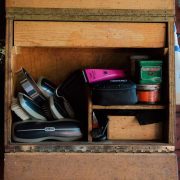On Being A Jumper Rider With A Dressage Trainer

By Cathy Sobke
There are numerous articles out there that have highlighted the benefits of dressage trainers working with jumper riders. But what about when you actually are that jumper rider with a dressage trainer? What is it like to be “That” rider? Does that mean endless circles, flawless lead changes, and a seat so sophisticated that it speaks to the horse like a conductor directing a symphony? Well, maybe for the better riders it does.
Take Beeze Madden, who in the course of a flatting demo can nail a line of one
tempis. That is not me. But I have learned a new approach to lessons and flat work through my training with a dressage trainer which has benefitted my riding in some unexpected ways.
I did not seek out a dressage trainer to help me with my jumping. I was not opposed to the idea, but it seemed like eating kale – good for you but not something I was going to voluntarily do on my own because I simply did not have the motivation to do something THAT good for myself. It just seemed like a lot of flat work when what I really wanted to be doing was flying over some fences.
But life took me in that direction anyway and I actually started working with my trainer due to a combination of other factors, mostly due to scheduling and availability. When we started to work together, I expected a lot of circles. And I was not wrong, we stayed on a circle for pretty much the first month or two of lessons. However, it was not so much a circle, as a round-ish shape. I was never told my circle was not the proper shape or was too uneven. The movement was not about tracing the perfect circle, so much as it was using a bend to put my horse correctly around my inside leg and maintaining proper connection with my outside rein.
In fact I still do not know if I am making a proper 20-meter circle, I am just told to make them small, medium, or large. However I definitely see a difference in how I am able to engage my horse’s inside hind end and create impulsion.
The biggest surprise to me was actually the amount of canter work we did. Continuously. Without stopping. I still remember how I thought I was going to die during the first lesson. I had gotten into the habit of doing a couple laps around the ring at the canter as a warm-up, and then moved back down to the walk or trot for a walk breather. Not with this trainer.
We kept cantering for what seemed forever. However, in retrospect the point was not to kill me or to get me to take up tennis, but rather to work the canter until we had a good working cadence that stayed consistent, and from there, a canter that I could then collect and move forward. For us, that took quite a bit of time and is still something we work on almost daily.
The problem with how I had approached my canter warm-up is that I did not stay in the canter long enough to establish any sort of regular rhythm. By the time I was just getting started, I was taking a break and neither me nor my horse had a chance to practice a good, forward rhythm.
The other biggest difference I have noticed in working with a dressage trainer, and this may just be specific to my trainer and not dressage trainers in general, is that we generally do one exercise per lesson and build on that specific exercise as the lesson progresses. With some of the jumper trainers with whom I worked, we would start on one line, and once we satisfactorily rode that line, we would move onto another exercise or line. However, with my current trainer, we stick
with that first line, whether it is a crossrail or cavelletti, and incorporate it as we progress throughout the lesson.
The methodology is almost scientific, in that we do the same exercise and
change one specific variable at a time, thereby narrowing the possible variables that cause a different outcome. This applies at home or at the show, where my trainer would rather I do the same exact course at one hole higher than do two different courses at the same height.
Admittedly, we are not really competitive at the shows, more just trying to get some positive miles in a competition atmosphere. But this approach has highlighted a very simple but important keystone of her training- consistency is paramount (See also canter work mentioned above).


